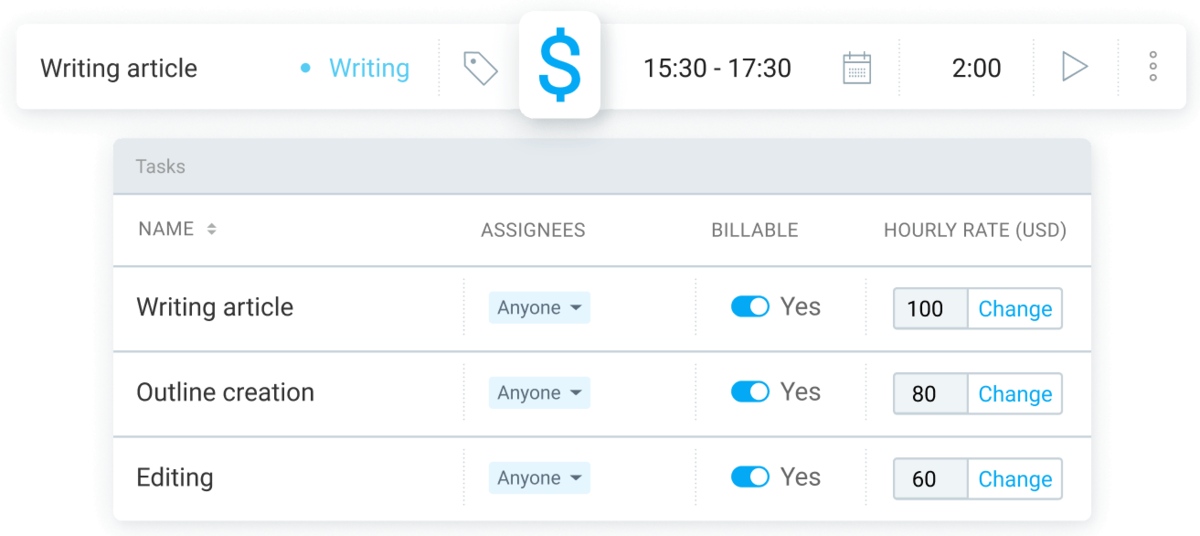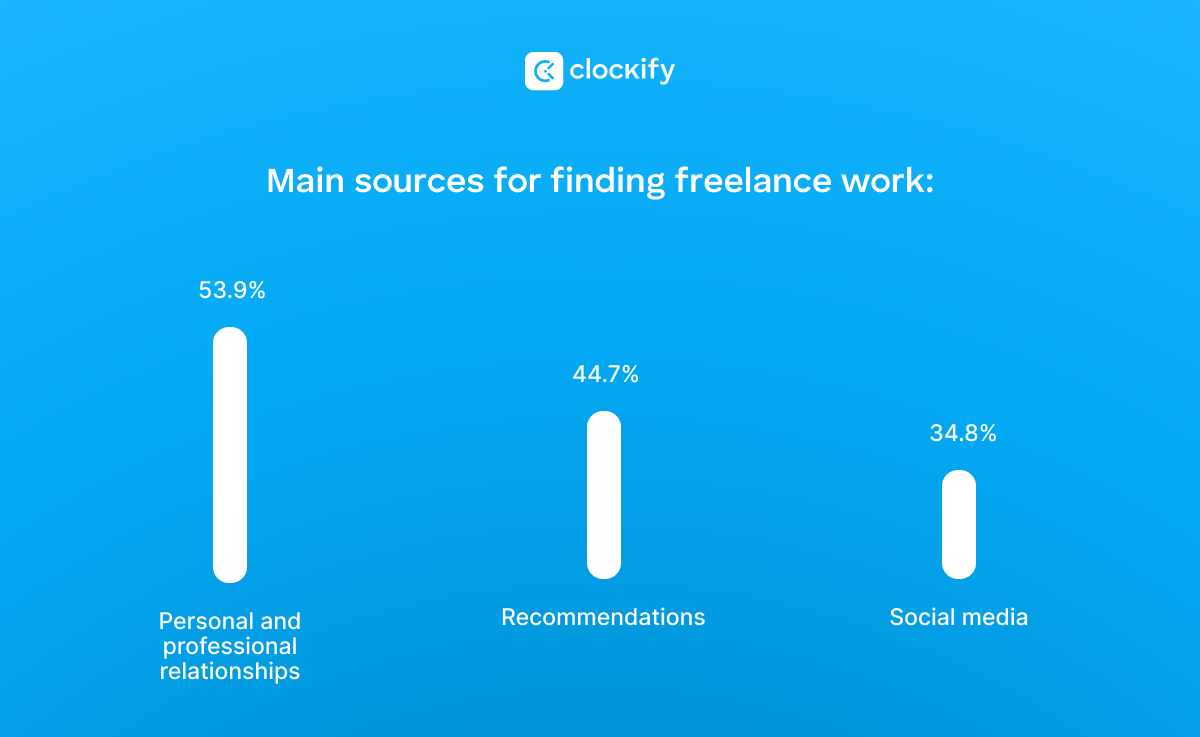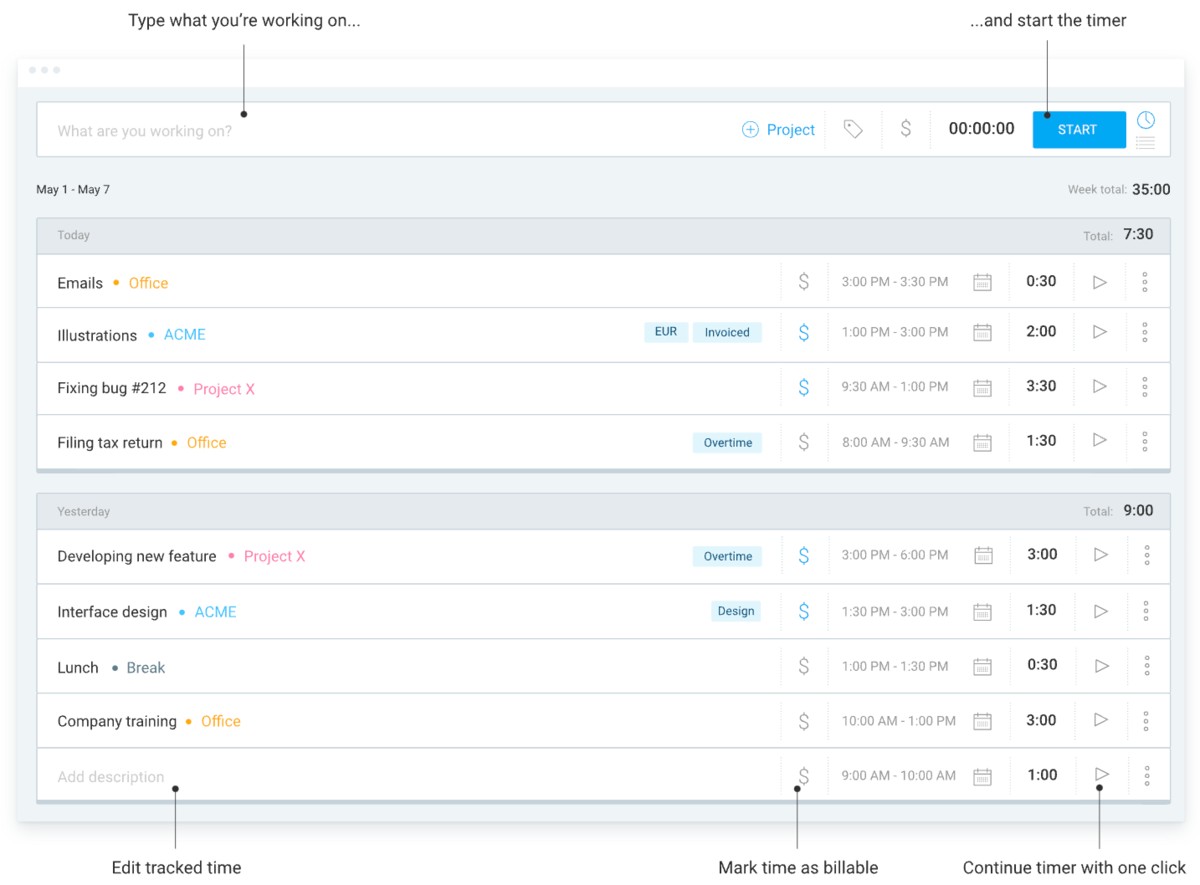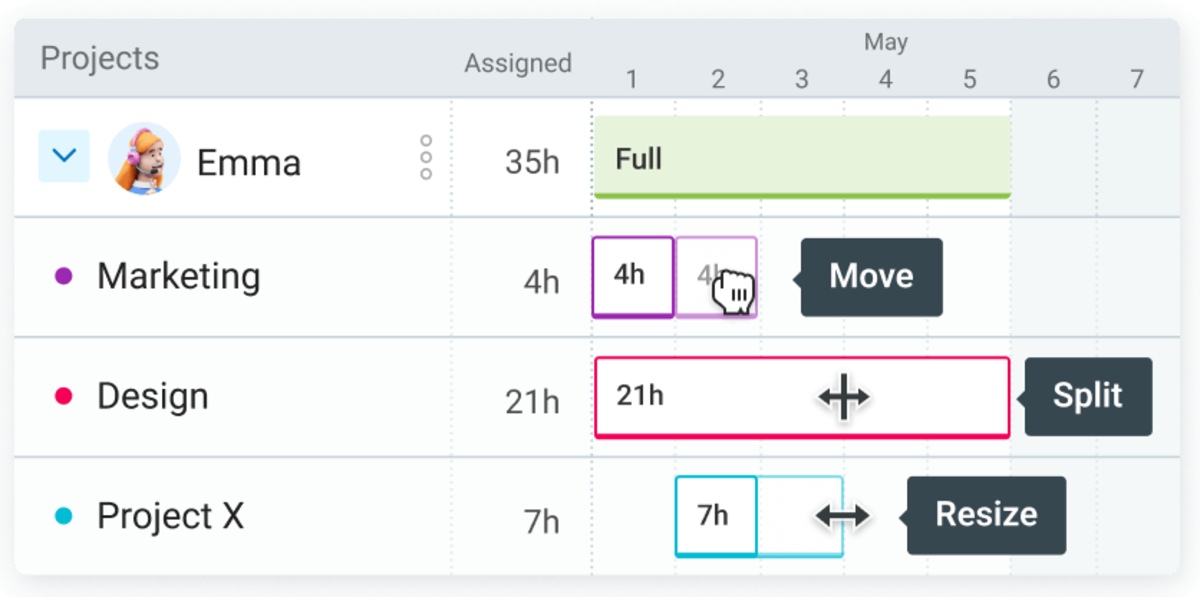Up to 80% of knowledge workers want more flexibility — which coincides with the ongoing rise of freelance work. And more US companies are open to hiring freelancers every year.
But how do you get into the freelance business?
Here’s how to start freelancing while keeping your day job for both beginners and seasoned professionals.

Table of Contents
How to start freelancing (or moonlighting)
Freelancing refers to working a second job alongside full-time work, typically at night. That’s why freelancers are also known as moonlighters — inspired by the idea of working under the moonlight.
Based on the 2024 State of Independence research, 37% of Americans with a traditional job also have a side gig. The study also showed that US employees mainly adopt side hustles to:
- Increase their income (42%),
- Pursue a passion (30%), and
- Build a business (27%).

Track freelance projects with Clockify
Whatever the reason, you’ll need to consider the following steps to start freelancing alongside a full-time job.
#1: Define your business goals
Decide whether you’re considering freelance as a side gig or a full-time business.
Your choice will determine the trajectory of your freelancing journey. More specifically, you’ll either aim to balance your day job and freelance work or transition fully into freelancing.
According to CEO Chris Sorensen (who has managed freelancers many times), the first step to freelancing is to clarify your intentions:

“Determine if you’re freelancing for extra income, career growth, or for the goal of transitioning into full-time self-employment.”
Once you define your long-term goal, create a game plan to achieve it. For instance, set several short-term goals and answer questions like:
- What niche will you specialize in?
- What services will you offer?
- What monthly amount do you want to earn before quitting your regular job (if applicable)?
Knowing why you’re pursuing freelancing and what you hope to achieve will help launch your career.
💡 CLOCKIFY PRO TIP
Understand long-term and short-term planning and get tips on how to handle both successfully in the following blog post:
#2: Find a perspective niche (and stick to it)
To succeed in the freelance business, you’ll have to specialize in a particular work area — whether you’re a copywriter or graphic designer.
For example, you can begin your content writing career by tackling various topics to find your ideal niche. After all, clients need area-specific content more often than general material.
Likewise, as a budding graphic designer, you should consider:
- Your level of experience,
- The current pool of connections, and
- Natural inclinations to a particular niche.
Then, pick and focus on your design field — whether it’s creating visuals for websites or designing product packaging.
On building a freelance career, Forbes suggests that narrowing down your services can set you apart from your competitors.
You can occasionally work outside your field but prioritize building a strong reputation in your chosen work area.
This will increase your chances of landing side gigs with reputable companies looking for experts in a particular niche.
Track your learning time with Clockify
#3: Identify target clients
Instead of catering to the global market, focus on the needs of a specific audience.
Different customers may require the same type of service you’re offering — like small businesses, remote workers, and other freelancers. Regardless, you should target 1 or 2 types of clients.
Similar to choosing a niche, selecting a target market will help jumpstart your freelancing journey. To identify target clients, create a customer profile based on these key points:
- Psychological factors — client’s belief system, including their lifestyle, aspirations, and views,
- Personal interests — what clients do in their free time and how they spend money, and
- Demographics — client’s age, gender, education level, location, and income.
With this information, you can create an offer that clearly targets your desired audience.
For example, as a content writer, you could write for female Millennial graduates from the US looking to start a social media career while traveling on a budget.
This strategy is specific enough to attract the right audience but general enough not to alienate other potential clients.
Overall, you’ll better understand which services to offer and where and how to market them.
💡 CLOCKIFY PRO TIP
Explore our thorough overview of the top freelance marketplaces.
#4: Set your freelance rates
Defining your freelance rates can feel like an intimidating task. So, let’s list the necessary parameters that will help determine your ideal pricelist:
- Your experience (if any),
- Your education level,
- Supply and demand for your services,
- Average hourly rates among freelancers in your niche,
- Prices in your industry, and
- Your location.
Set freelance rates in Clockify

Clockify lets you easily define freelance rates to track your earnings. Simply specify your billable rate (the hourly amount you charge clients) and mark time entries as billable.
“It’s important for me to provide clients with the accurate amount of work that I did so that they can see what they’re paying for. Clockify allows me to invest more time into what I do best rather than paperwork or counting hours.”
– Elijah D, Graphic designer
After collecting the listed data, you can calculate your hourly rate. For instance, higher education, ample experience, and constant demand for your services allow you to set higher prices.
In 2024, North America had the highest average hourly rate in the world, $56 per hour. So, if you’re based in this area, you can command higher rates. However, you would have to balance your prices with the country’s high living standards and expenses.
💡 CLOCKIFY PRO TIP
Below are the solutions for freelancers looking to calculate ideal hourly rates and convert hours into earnings:
When pricing your services, don’t price yourself too high in relation to the above parameters. Otherwise, you’ll appear too expensive compared to your competition.
Don’t sell yourself short, either. You’ll need to cover your freelance expenses and still make a profit. So, study your competitors’ offers to learn where you stand on the market.
#5: Create a website (and portfolio)
To create an online presence, you’ll need to dabble in web development — i.e., build a website with a portfolio showcasing your work.
You’ve got 2 choices — create a website for free with a website builder like Wix or buy a domain name from a hosting website. In the latter case, you’ll get a unique site name and a customized email address to appear more professional.
Based on a recent paper on website design, you can build a platform in 4 steps:
- Choose a website builder — pick a web builder that’s most practical and matches your needs,
- Select a template — decide which pre-designed theme best suits your brand and work area,
- Customize pages — tweak your content to reflect your website’s purpose and include pages like:
- Home page — summarize your website content,
- Product or service page — present your products or services and their prices,
- About page — include your biography and outline your goals,
- Portfolio page — build your portfolio and feature your best work (e.g., an overview of your articles),
- Blog page — write about industry-related topics, and
- Contact page — include your contact details.
- Optimize content for search engines — include popular industry keywords to boost Google ranking and attract clients.
💡 CLOCKIFY PRO TIP
Use KPIs to see how well your website is performing — e.g., the number of views your web pages receive:
#6: Find your first client
While your portfolio may attract the first client, you should continue pursuing gigs and advertise your offer.
On freelancers’ marketing struggles, PR strategist Laura Podesta says:

“A big hurdle when people decide to work for themselves is that they don’t like to market themselves — but it’s essential to get clients.”
So, here’s how to start freelancing through self-promotion:
- Join your industry’s community — find a forum that hosts industry-related discussions to learn from other freelancers and clients. A report on sources of gig work showed that freelancers mainly find work through:
- Personal and professional relationships,
- Recommendations, and
- Social media.

- Learn how to pitch through email — send cold emails to potential customers to pitch your expertise and skills. Your first customer can provide a referral, helping you gain experience and credibility. To craft your email pitch, you should:
- Be concise and informative,
- Address people by name,
- Mention current clients and how you help them,
- Highlight positive outcomes that customers gain from your services,
- Include a call-to-action (CTA) to encourage collaboration.
💡 CLOCKIFY PRO TIP
Juggling emails and tasks can put freelancers in a time crunch. Read this text to master email management and stay productive:
- Explore freelance job platforms — join target industry-specific websites instead of popular, crowded platforms like Upwork or Fiverr. To increase your chances of success, join less-known alternatives, like:
- Designhill — art and design side hustles,
- Guru — jobs in programming, graphic design, and project management,
- ServiceScape — writing-related gigs, and
- Codeable — WordPress developer jobs.
#7: Expand your network
Once you secure your first customer, focus on finding regular clients to ensure a steady stream of work.
That’s where the Pareto principle comes in handy. According to this rule, cultivating a strong relationship with 20% of your clients will help you find 80% of new work through their recommendations. So, for every 20 referrals, your chances of landing new projects increase by 80%.
To expand your client base, you can:
- Participate in industry webinars,
- Attend business events, like conferences or networking meetups,
- Join online communities like Facebook groups,
- Streamline your social media network, and
- Send out invites to field professionals.
Before you start growing your client pool, make sure that you comply with the local freelancing laws — which we’ll discuss next.
#8: Explore the legal and tax requirements
To start a freelance job while working full-time, check your company’s policy on working side hustles. Perhaps your contract forbids you from accepting freelance work in your chosen niche.
Legally, freelancers are self-employed individuals who work for multiple clients and have tax responsibilities. They’re often associated with independent contractors, who usually work full-time for a single client long-term.
According to the IRS on self-employed tax obligations, people who are self-employed have to make quarterly payments, including:
- Self-employment tax — covers Social Security and Medicare taxes, and
- Income tax — calculated based on your income level (total business income minus expenses).
Create tax-inclusive invoices with Clockify
Attorney Benjamin Michael addresses common legal mistakes and consequences for inexperienced freelancers:

“New freelancers often don’t realize that they have to pay quarterly taxes because nobody is going to remind them. When tax season rolls around, and you haven’t made these payments, you can be hit with steep fines.”
Furthermore, check your state’s laws to see if you need a permit to sell your products or services. Your state license will vary based on your business activities and location, as will your permit fees and expiration dates.
A license proves that you’re qualified to work in a field and follow local regulations. So, having one could boost your reputation and trust among potential customers.
💡 CLOCKIFY PRO TIP
Use tax deductions for self-employed people to lower your taxable income — and decrease the amount you owe the IRS:
Balance your full-time job with part-time freelancing
Now that you’ve learned how to start freelancing, here’s the next conundrum:
How do you keep your regular job while freelancing?
Freelancers with full-time jobs usually depend on them to cover:
- Utility bills,
- Taxes,
- Healthcare,
- Retirement fund, and
- Other expenses.
Monitor your expenses with Clockify
So, you should prioritize your 9-to-5 job over part-time gigs.
Career entrepreneur Jeremy Yamaguchi identifies the biggest challenge for freelancers with day jobs — the workload:

“If you’re still working a full or part-time job, don’t bite off more than you can chew. Take on just one gig or a couple. You can start figuring out how long certain tasks take you.”
As a full-time employee and freelancer, you should also define your priorities and create a daily schedule to manage project deadlines and achieve peak productivity.
💡 CLOCKIFY PRO TIP
Use our printable, free schedule templates to manage time better and prioritize tasks:
Furthermore, a 2024 survey on freelancers’ habits showed that 45.5% of the surveyed participants spend 5 to 6 hours per day on freelance jobs. So, when you work full-time and take on side gigs, you may end up working 80+ hours per week.
To prevent burnout and stay productive, protect your mental health and leave sufficient time for meals, sleep, exercise, and leisure time.
💡 CLOCKIFY PRO TIP
Freelancers have to monitor their business expenses, transactions, and monthly goals. Here’s how you can do it:
How to start freelancing without experience
So far, our freelancer’s guide covered steps to building a freelance career for both newbies and pros. Now, let’s focus solely on beginners who are learning how to start freelancing.
As a newcomer, you’ll face multiple challenges — from finding your true (freelance) calling to competing with professionals.
Let’s explore ways to approach the matter.
#1: Choose what you’re passionate about
Identify your passions and interests. If this happens to be a programming language, you’re off to an excellent start. But there are many profitable markets worth exploring before making your decision.
Just because a particular industry is thriving doesn’t mean you’ll enjoy working in it. In fact, Yoh’s study on employee dissatisfaction found that:
- Only 28% of working Americans love their jobs, and
- 1 in 7 American employees want to leave their job within a year.
So, here’s how to properly determine what work area best suits your needs:
- List 10-15 of your interests and passions. Working in an industry you love will make you less likely to quit during hard times.
- Identify the most searched problems and topics within each listed industry or niche. Monitoring apps for freelancers, like a keyword analysis tool, can tell you the monthly search volume of a certain term.
- Browse industry-related forums to pinpoint people’s most common problems and concerns. Your services may present a solution to their needs, filling a gap in the market.
- Analyze your competitors to see if they’ve already addressed the issues you’re exploring. Either way, you may provide a better deal for potential customers, outmatching competitors’ offers.
💡 CLOCKIFY PRO TIP
Among in-demand freelance roles, the virtual assistant (VA) market has grown exponentially. Find out how to land a VA job:
#2: Consider side jobs that don’t require experience
If you’re interested in a quick-start side gig, there are ample opportunities that require no experience.
According to Forbes, here are the top 3 remote jobs you can start without experience in 2025:
- Virtual Assistant — complete administrative work for small businesses, including booking calls and responding to clients,
- Copywriter — write on topics that interest you and apply for copywriting gigs, and
- SEO Optimization Specialist — watch free online courses to develop your SEO (search engine optimization) skills.
Additionally, you can secure beginner-friendly gigs by leveraging strong skills, including:
- Typing skills — offer data entry assistance,
- Research skills — assist teams by conducting internet research, and
- Language proficiency — apply to transcribe audio to text.
Regardless of your choice, supplementing your income with easy gigs will require solid time management skills. To stay disciplined, monitor your time use with simple time trackers like Clockify.

“Clockify is easy to use and anybody can pick it up quickly. It’s an easy tool for billing the hours worked and reviewing the time spent on projects and tasks through reports. You can set up time tracking for specific clients, projects, and tasks — this is very granular and comprehensive.”
– Subash B, Co-founder of a marketing and advertising company
Quick side gigs may better match your needs — but they’ll be harder to find due to larger competition.
💡 CLOCKIFY PRO TIP
Discover how to split time between your regular job and side hustle — and protect your work-life balance:
#3: Don’t work for exposure
New freelancers are usually tempted to offer low-cost services in exchange for more exposure.
However, providing free services for the promise of future work is a trap.
Mellow’s 2024 report on global contractor recruitment revealed that the number of North American businesses hiring contractors has increased by 260% since 2022. So, undercharging could give a growing number of freelance clients the wrong impression of your skills.
In truth, free work is easier to promote, allowing you to build your portfolio and get hired more often. However, as more people hear about your free services, landing paying gigs will become difficult.
Generally, people tend to compare freelance prices with service quality. If they start doubting your expertise, you’ll likely lose respect, credibility, and recognition — the building blocks of your reputation.
In short, you should never underestimate your worth and always look for paying gigs.
💡 CLOCKIFY PRO TIP
If you’ve decided to charge your clients as a new freelancer, but you don’t know how to price your work correctly, check out the following blog posts:
#4: Work on your freelance skills
Do you lack the experience and skills necessary for quality work? Start learning and practicing.
Naturally, this solution may inconvenience full-time employees who are already in a time crunch. But you can devote some of your leisure time to productive activities — like reading industry news or taking online Udemy courses.
Elevate productivity with Clockify
Also, don’t hesitate to ask other freelancers for constructive feedback on your work. Their expert suggestions will help you identify your strengths, weaknesses, and improvement areas.
You can gain practical knowledge by frequenting niche-oriented websites that explore the theory behind your work. Then, use your free time to practice and improve your skills — whether by coding or writing.
#5: Polish your soft skills
Apart from industry-related freelance skills (i.e., hard skills), you’ll need to enhance your non-technical skills (i.e., soft skills). Soft skills are personality traits that describe how you work and engage with others — like critical thinking, time management, and efficient scheduling.
According to Forbes, here are the top 5 soft skills for high-income side jobs:
- Communication — successfully negotiating with clients from all walks of life and promoting your freelance business,
- Time management — balancing your work and life with irregular hours by scheduling your day,
- Problem-solving — solving issues of different complexity to satisfy clients’ needs,
- Organization — setting clear goals to stay motivated and productive while improving customer loyalty, and
- Growth mindset — reflecting on your practice, listening to customer feedback, and taking steps toward improvement.
Boosting your confidence can help prevent productivity guilt — feelings of shame and dissatisfaction caused by the constant pressure to be productive.
Most importantly, you should nurture discipline. After all, you’ll have to balance your full-time job and freelance projects — on top of your personal errands.
How to start freelancing in a particular niche
Previously, we covered how to start freelancing in general — regardless of your experience and chosen industry. Now, we’ll identify popular career options for freelancers and how to get started.
Freelancing in web development
To begin a web developer career, you should:
- Choose your developer specialty:
- Front-end developer — codes the interface of websites and apps (visible parts that users interact with),
- Back-end developer — works on components that users can’t see (like servers or databases) to ensure that websites and apps run correctly, and
- Full-stack developer — works on both the back-end and front-end components of websites and apps.
- Find an experienced web developer to partner with and learn from.
- Divide daily work into time blocks to practice soft skills like time management.
- Showcase your work (e.g., developed apps) on GitHub and similar places to attract clients.
- Contact startups and local organizations to see if they require web development services.
- Create an eCard (virtual business card) and send it to your email contacts to announce what services you’re offering.
- Educate the public about your craft for more self-promotion — by writing guest posts or making YouTube videos.
- Browse job boards and websites for freelance developers, like Guru.
Track developer projects with Clockify
💡 CLOCKIFY PRO TIP
The apps below can help bolster your performance as a freelance web developer:
Freelancing in graphic design
To kickstart your career as a graphic designer, you should:
- Ensure that your website design stands out among the competition. To build your brand identity, create a website with these components:
- Logo — memorable logo design,
- Colors — color palette with key brand colors,
- Typography — selection of specific font styles and sizes,
- Visuals — icons and images that match your brand style, and
- Content — core messages, slogans, and product descriptions that align with your brand values.
- Create new, innovative graphics and showcase them in your portfolio.
- Join a community of freelance designers and attend events to establish yourself as a knowledgeable designer.
- Befriend freelancers whose skills complement yours and team up to work on projects or refer each other to clients.
- Meet with customers in person or online to negotiate prices and requirements — this way, you can protect your financial interests and appear trustworthy.
- Create a paid trial plan for clients to test your services for a limited time. It’s a practical solution if you’re unsure about web design pricing and tempted to offer free work.
- Get the right equipment and software for the best performance — including a powerful computer, graphic design apps, and productivity tools. Luckily, you can use free versions of tools like Canva for design and Clockify for timekeeping.
- Go through job boards and websites for freelance designers, like Dribble.
The path to success looks different in all professions, requiring particular skills and strategies. Next, let’s explore what it takes to become a freelance writer.
Freelance writing
To jumpstart your freelancing journey as a writer, you should:
- Write every day to expand your skills and keep them sharp. To form a strong writing habit, use time management methods like Don’t Break the Chain:
- Get a calendar,
- Mark each day that you repeat the habit, and
- Build a streak and stay consistent.
- Run a blog to promote your writing prowess. Forbes suggests using free blogging platforms like Wix or Weebly for new bloggers exploring niche ideas.
- Publish guest posts on reputable blogs in your respective niche for extra promotion.
- Stay informed about industry trends and news. This way, you can explore ideas for your next writing pitch.
- Learn about content editing and managing images (organizing and adjusting visuals in your writing). Investing in your professional development will help improve your performance and retain clients.
- Carefully craft cold email pitches — they provide a first glimpse into your writing skills. A weak pitch with grammar mistakes will persuade addressees to decline your proposal.
- Check job boards and websites for freelance writers, like ProBlogger.
Boost writing productivity with Clockify
FAQs about freelancing
The most common questions about freelancing reveal the biggest concerns of current freelancers and those considering it. Our answers should provide comfort and useful information to the community.
Which type of freelancing pays the most?
Understandably, loving what you do often isn’t enough to pay the bills. Naturally, you’ll look for lucrative freelance opportunities.
Here are some of the highest-paying freelance jobs in 2025:
- Software engineer — designs and maintains complex software systems for an average yearly income of $94,943,
- Business Consultant — guides businesses in improving operations and profits for the average annual sum of $82,416,
- Marketing Manager — offers strategic marketing advice to increase clients’ online presence for an average yearly income of $73,907,
- Photographer — takes high-quality pictures for various events and businesses for an average annual sum of $69,360, and
- Copywriter — writes informative or publicity texts for clients for an average yearly income of $60,109.
Though some jobs require prior experience and high education, others don’t. Photographers and copywriters are often self-taught creative individuals. All it takes is a camera or laptop and a few completed courses to join their ranks.
Monitor your earnings with Clockify
What is the easiest freelance job to get?
Though we already covered beginner-friendly gigs, they aren’t necessarily the easiest to get. An easy job is one you’re personally skilled in. So, explore your abilities, preferences, and tendencies to identify jobs that best suit them.
To do so, you can answer the following self-assessment questions:
- How do you like to work?
- What environment do you like to work in?
- What issues do you want to tackle?
- What are your lifestyle needs?
- How do you view success?
- What compromises are you okay making?
Career assessments help pinpoint your passions, strengths, and goals to find a job that fits your personality.
💡 CLOCKIFY PRO TIP
Personality tests can provide career guidance but can’t predict your job performance. Discover ways to stay productive based on your traits.
Freelance and keep your 9-to-5 job with Clockify
Having a day job and a freelance business may seem like walking a tightrope between office duties and client deadlines.
But you have enough hours in the day to juggle both careers and maintain a healthy work balance.
Enter Clockify by CAKE.com — a simple yet effective time tracker that helps you pinpoint the lost hours in your schedule.
Our app helps you see the time spent and profits earned per each activity. No matter the industry, Clockify’s flexible features let you successfully run a freelance business while employed — here’s how it works:
- Schedule — create a work schedule to map out daily goals and avoid overbooking yourself.

- Reports — view a detailed breakdown of billable and non-billable hours or expenses for a selected time range.
- Invoices — generate invoices for your clients based on billable tracked time and expenses (like overtime work).
By scheduling everyday tasks, you can keep your day job and side business separate. Knowing your daily agenda will help you resist multitasking and stay productive.
Clockify’s invoices let you automate the billing process and provide tangible proof for every minute worked.
Finally, thorough performance reports help you build productive habits, while expense reports show how your money is spent and where to cut costs.
Among our app’s different plans, the PRO plan may best suit your freelancing needs — it includes the standard features, plus expense tracking based on fixed or hourly fees. Our paid plans include free onboarding services to help with any business obstacles.
However, our 24/7 support is available to everyone, no matter the plan.
With Clockify’s support, you can polish soft skills like time management and scheduling, while automated billing lends you credibility and security.



